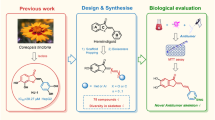Abstract
Hesperadin is one of the indolinones that was designed against the ATP-binding site of Aurora kinase. This molecule inhibits Aurora B kinase by phosphorylation of histone H3. In this study, new derivatives of Hesperadin containing an amide group in their structures were synthesized through sequential Ugi/palladium-catalyzed approach and in vitro antitumor activity of new compounds were evaluated by cell proliferation assay. The results show that compounds 6f, 6i, 6l, and 6o were dose-dependently inhibited in different concentrations, and IC50 values were between 35 and 43 nM. It seems that lipophilic substitution on the indolinone core with the ability to form additional hydrogen bond might lead to increased stability of structure and activity of new Hesperadin analogues.




Similar content being viewed by others
References
Adams RR, Maiato H, Earnshaw WC, Carmena M (2001) Essential roles of Drosophila inner centromere protein (INCENP) and aurora B in histone H3 phosphorylation, metaphase chromosome alignment, kinetochore disjunction, and chromosome segregation. J Cell Biol 153(4):865–880
Bararjanian M, Hosseinzadeh S, Balalaie S, Bijanzadeh HR (2011) Palladium catalyzed stereoselective synthesis of 3-(anilinoarylmethylene)-2-oxindoles as Hesperadin analogoues. Tetrahedron 67(14):2644–2650
Boss DS, Beijnen JH, Schellens JH (2009) Clinical experience with aurora kinase inhibitors: a review. Oncologist 14(8):780–793. doi:10.1634/theoncologist.2009-0019
Carmena M, Earnshaw WC (2003) The cellular geography of aurora kinases. Nat Rev Mol Cell Biol 4(11):842–854. doi:10.1038/nrm1245
Carvajal RD, Tse A, Schwartz GK (2006) Aurora kinases: new targets for cancer therapy. Clin Cancer Res Off J Am Assoc Cancer Res 12(23):6869–6875. doi:10.1158/1078-0432.CCR-06-1405
Ditchfield C, Johnson VL, Tighe A, Ellston R, Haworth C, Johnson T, Mortlock A, Keen N, Taylor SS (2003) Aurora B couples chromosome alignment with anaphase by targeting BubR1, Mad2, and Cenp-E to kinetochores. J Cell Biol 161(2):267–280
Fu J, Bian M, Jiang Q, Zhang C (2007) Roles of Aurora kinases in mitosis and tumorigenesis. Mol Cancer Res 5(1):1–10. doi:10.1158/1541-7786.MCR-06-0208
Giet R, Petretti C, Prigent C (2005) Aurora kinases, aneuploidy and cancer, a coincidence or a real link? Trends Cell Biol 15(5):241–250. doi:10.1016/j.tcb.2005.03.004
Goodsell DS, Morris GM, Olson AJ (1996) Automated docking of flexible ligands: applications of AutoDock. J Mol Recognit 9:1–5
Harrington EA, Bebbington D, Moore J, Rasmussen RK, Ajose-Adeogun AO, Nakayama T, Graham JA, Demur C, Hercend T, Diu-Hercend A, Su M, Golec JM, Miller KM (2004) VX-680, a potent and selective small-molecule inhibitor of the Aurora kinases, suppresses tumor growth in vivo. Nat Med 10(3):262–267. doi:10.1038/nm1003
Hauf S, Cole RW, LaTerra S, Zimmer C, Schnapp G, Walter R, Heckel A, van Meel J, Rieder CL, Peters JM (2003) The small molecule Hesperadin reveals a role for Aurora B in correcting kinetochore-microtubule attachment and in maintaining the spindle assembly checkpoint. J Cell Biol 161(2):281–294. doi:10.1083/jcb.200208092
Hontz AE, Li SA, Lingle WL, Negron V, Bruzek A, Salisbury JL, Li JJ (2007) Aurora a and B overexpression and centrosome amplification in early estrogen-induced tumor foci in the Syrian hamster kidney: implications for chromosomal instability, aneuploidy, and neoplasia. Cancer Res 67(7):2957–2963. doi:10.1158/0008-5472.CAN-06-3296
Keen N, Taylor S (2009) Mitotic drivers–inhibitors of the Aurora B Kinase. Cancer Metastasis Rev 28(1–2):185–195. doi:10.1007/s10555-009-9184-9
Kitzen JJ, de Jonge MJ, Verweij J (2010) Aurora kinase inhibitors. Crit Rev Oncol Hematol 73(2):99–110. doi:10.1016/j.critrevonc.2009.03.009
Ladygina NG, Latsis RV, Yen T (2005) Effect of the pharmacological agent hesperadin on breast and prostate tumor cultured cells. Biomed Khim 51(2):170–176
Morris GM, Goodsell DS, Halliday RS, Huey R, Hart WE, Belew RK, Olson AJ (1998) Automated docking using a Lamarckian genetic algorithm and empirical binding free energy function. J Comput Chem 19:1639–1662
Morris GM, Huey R, Lindstrom W, Sanner MF, Belew RK, Goodsell DS, Olson AJ (2009) AutoDock4 and AutoDockTools4: automated docking with selective receptor flexibility. J Comput Chem 16:2785–2791
Ota T, Suto S, Katayama H, Han Z-B, Suzuki F, Maeda M, Tanino M, Terada Y, Tatsuka M (2002) Increased mitotic phosphorylation of histone H3 attributable to AIM-1/Aurora-B overexpression contributes to chromosome number instability. Cancer Res 62(18):5168–5177
Pollard JR, Mortimore M (2009) Discovery and development of aurora kinase inhibitors as anticancer agents. J Med Chem 52(9):2629–2651. doi:10.1021/jm8012129
Sausville EA (2004) Aurora kinases dawn as cancer drug targets. Nat Med 10(3):234–235
Sessa F, Mapelli M, Ciferri C, Tarricone C, Areces LB, Schneider TR, Stukenberg PT, Musacchio A (2005) Mechanism of Aurora B activation by INCENP and inhibition by hesperadin. Mol Cell 18(3):379–391. doi:10.1016/j.molcel.2005.03.031
The Electronic Protocol Book. A Quick and Practical Guide for Biologists. Available at http://www.changbioscience.com/protocols/
Vader G, Medema RH, Lens SM (2006) The chromosomal passenger complex: guiding Aurora-B through mitosis. J Cell Biol 173(6):833–837
Acknowledgments
The authors are grateful to Miss Sedigheh Mirzaei, for carrying out the statistical analyses.
Author information
Authors and Affiliations
Corresponding author
Rights and permissions
About this article
Cite this article
Shamsipour, F., Hosseinzadeh, S., Arab, S.S. et al. Synthesis and investigation of new Hesperadin analogues antitumor effects on HeLa cells. J Chem Biol 7, 85–91 (2014). https://doi.org/10.1007/s12154-014-0111-3
Received:
Accepted:
Published:
Issue Date:
DOI: https://doi.org/10.1007/s12154-014-0111-3




